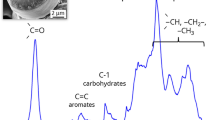Summary
NMR (nuclear magnetic resonance) spectroscopy was used to identify metabolic solutes in one normal and two habituated sugarbeet cell lines (Beta vulgaris L.altissima) obtained from the same mother strain. This technique was applied to investigate the intracellular naturally occurring13C isotopes (1.1% of total natural carbon) in living sugarbeet suspension cells and perchloric cell extracts. A combination of1H,13C, double-quantum filter correlation spectroscopy, heteronuclear multiple-bond correlation, and heteronuclear multiple-quantum coherence spectra from perchloric cell extracts enabled us to identify the main compounds in the different extract solutions. This was verified by spiking the solutions with small amounts of reference compounds to exclude the influence exerted by pH on the chemical shifts of the different compounds in the1H and13C spectra. The comparison of the three sugarbeet cell lines' NMR spectra showed the presence of sucrose, glucose, and fructose in the three strains. On the other hand, it revealed a strong discrepancy between metabolic solutes. Spectra from the habituated lines showed the presence of glutamine. Some amino acids such as alanine or valine, and unidentified signals corresponding to aromatic rings were only characterized in the habituated nonorganogenic cells. On the basis of these13C NMR data we assumed that the discrepancy between the different sugarbeet cell lines could be due to an increase in the metabolic activity of the habituated cell lines in relation to their autonomous growth.
Similar content being viewed by others
Abbreviations
- DQF-COSY:
-
double-quantum filter correlation spectroscopy
- HO:
-
habituated organogenous
- HNO:
-
habituated nonorganogenous
- HMBC:
-
heteronuclear multiple-bond correlation
- HMQC:
-
heteronuclear multiple-quantum coherence
- N:
-
normal
- NMR:
-
nuclear magnetic resonance
- TSP:
-
sodium tetradeutero-3-(trimethylsilyl)-propionate
References
Ashworth DJ, Lee RY, Adams DO (1987) Characterisation of acetate and pyruvate metabolism in suspension cultures ofZea mays by13C NMR spectroscopy. Plant Physiol 85: 463–468
Braun AC (1978) Plant tumors. Biochim Biophys Acta 516: 167–191
Bental M, Oren-Shamir M, Avron M, Degani H (1988)31P and13C NMR studies of the phosphorus and carbon metabolites in the halotolerant alga,Dunaliella salina. Plant Physiol 87: 320–324
Chang K, Roberts JKM (1989) Observation of cytoplasmic and vacuolar malate in maize root tips by13C NMR spectroscopy. Plant Physiol 89: 197–203
Dijkema C, De Vries SC, Booij H, Schaafsma TJ, Van Kammen A (1988) Substrate utilisation by suspension cultures and somatic embryos ofDaucus carota L. measured by13C NMR. Plant Physiol 88: 1332–1337
Gautheret RJ (1955) Sur la variabilité des proprités physiologiques des culture de tissus végétaux. Rev Gen Bot 62: 1–10
Gout E, Bligny R, Pascal N, Douce R (1993)13C NMR studies of malate and citrate synthesis and compartmentation in higher plant cells. J Biol Chem 268: 3986–3992
Hagège D (1990) Étude comparative du cal normal et du cal habitué deBeta vulgaris L.altissima: aspects cytologiques, ultrastructuraux et biochimiques: relation avec l'état normal. Thèse d'état, Université de Caen, Caen, France
— (1996) Habituation in sugarbeet plant cell: permanent stress or antioxidant adaptative strategy? In Vitro Cell Dev Biol Plant 32: 1–5
—, Kevers C, Gaspar T, Thorpe TA (1991) Abnormal growth of habituated sugarbeet callus and cell suspension. In Vitro Cell Dev Biol 27: 112–116
Kevers C, Coumans M, De Greef W, Hofinger M, Gaspar T (1981) Habituation in sugarbeet callus: auxin content, auxin protectors, peroxidase pattern and inhibitors. Physiol Plant 51: 281–286
Medina AM, Sanchez-Jimenez F, Marquez J, Quesada AR, Nunez de Castro I (1992) Relevance of glutamine metabolism to tumor cell growth. Mol Cell Biochem 113: 1–15
Meins F Jr (1989) Habituation: heritable variation in the requirement of cultured plant cells for hormones. Annu Rev Genet 23: 395–408
—, Binns AN (1977) Epigenetic variation of cultured somatic cells: evidence for gradual changes in the requirement for factors promoting cell division. Proc Natl Acad Sci USA 74: 2928–2932
— — (1978) Epigenetic clonal in the requirement of plant cells for cytokinins. In: Substenly S, Sussex IM (eds). The clonal basis of development. Academic Press, New York, pp 185–201
Neeman M, Aviv D, Degani H, Galun E (1985) Glucose and glycine metabolism in regenerating tobacco protoplasts. Plant Physiol 77: 374–378
Negrutiu I, Beeftink F, Jacobs M (1975)Arabidopsis thaliana as a model system in somatic cell genetics. Plant Sci Lett 5: 293–304
Simpkin J, Collin HA, Street HE (1970) The growth ofAcer pseudoplatanus cell in a synthetic liquid medium: response to carbohydrate, nitrogenous and growth constituents. Physiol Plant 23: 385–396
Spikett MC, Smirnoff N, Ratcliffe RG (1992) Metabolic response of maize roots to hyperosmotic shock. Plant Physiol 99: 856–863
Stonier T (1969a) Studies of auxin protectors VI: preliminary studies on several Nicotiana tissue cultures. In Vitro 4: 130
— (1969b) Studies of auxin protectors VII: association of auxin protectors with crown gall development in sunflower stems. Plant Physiol 44: 1169–1174
- (1971) The role of auxin protectors in autonomous growth. In: Hirh ML, Morel G (eds) Les cultures de tissus de plantes. Colloq Int CNRS 193: 423–435
—, Yang HM (1972) Studies of auxin protectors X: protectors levels and lignification in sunflower crown gall tissue. Physiol Plant 25: 474–481
—, Yoneda Y (1967) Stem internode elongation in the Japanese morning glory (Pharbitis nil Choisy) in relation to an inhibition system of auxin destruction. Physiol Plant 20: 13–19
—, Hudek J, Vande-Stouwe R, Yang HM (1970) Studies of auxin protectors VIII: evidence that auxin protectors act as cellular poisers. Physiol Plant 23: 775–783
Ugarbil K, Brown TR, Den Hollander JA, Glynn P, Shulinan RG (1978) High resolution13C NMR studies of glucose metabolism inEschericia coli. Proc Natl Acad Sci USA 75: 3742–3746
Author information
Authors and Affiliations
Corresponding author
Rights and permissions
About this article
Cite this article
Omarzad, O., Pichon, R., Kervarec, N. et al. NMR natural abundance estimation of13C-metabolic solutes in normal and habituated sugarbeet cell lines. Protoplasma 202, 145–152 (1998). https://doi.org/10.1007/BF01282542
Received:
Accepted:
Issue Date:
DOI: https://doi.org/10.1007/BF01282542




